Entries in Magnolia Township (4)
10/4/10 A picture of a 500 foot turbine is worth 1000 words: Fifty story turbines go up in Town of Glenmore, Brown County, Wisconsin AND Rock County wind farm plans scrapped AND New Study says industrial scale wind farms affect temperature: how will this affect ag land, wildlife and natural habitat?
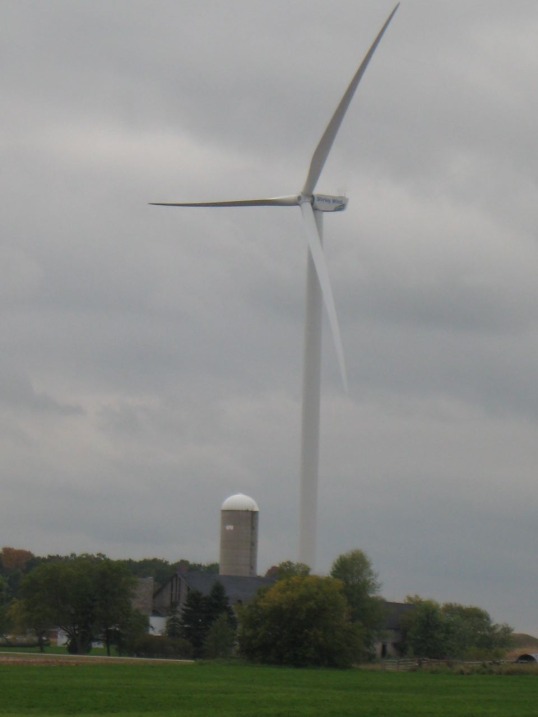
At 500 feet, the turbines going up in the Town of Glenmore in Brown County are the tallest in the state. Those in the wind industry continue to insist the presence of wind turbines has no effect on property values.
ACCIONA ENDS PLANS FOR WIND FARM IN MAGNOLIA
October 4, 2010
By Gina Duwe
MAGNOLIA TOWNSHIP — Plans that once called for up to 67 wind turbines dotting the countryside of Magnolia Township have ended.
An official with Acciona, a global energy company, confirmed that it has decided not to develop the EcoMagnolia project.
“That’s a case where I think … it was not an adequate wind resource for us to commit our full development for the project area,” said Chip Readling, lead developer for projects in several states, including Wisconsin.
Data gathered from a meteorological tower that stood for about three years at County B and Highway 213 showed “the project did not align well with our business goals,” he said.
“(It was) just a matter of wind,” he said.
Acciona still owns the project rights.
Plans are not as certain to the north.
The met tower that’s been up for nearly two years in Union Township will be taken down after the corn surrounding it is harvested.
The company’s meteorological team will analyze the data gathered from that tower—at County C and Highway 103—and decide whether to pursue a project, Readling said.
“We think it’s certainly a site we want to continue to watch,” he said.
If the company decides to move forward, the next step would be putting up a taller met tower—262 feet tall—to record wind speeds at the height of a turbine hub.
Readling said the company had no timeline and was not to the point of having landowners sign contracts.
He also said he could not release any of the wind speeds from either of the met towers.
In 2008, EcoEnergy said the average wind speed was 14.7 mph, measured at 197 feet on the Magnolia tower. The average was for a year starting in April 2007.
EcoEnergy first started the development of the Union project to include three turbines west of Evansville with Wisconsin Public Power buying the power produced for sale to Evansville Water and Light customers.
Acciona bought the rights for the Union and Magnolia projects from EcoEnergy in 2007.
Lost in the shuffle of the sale was the town permit for the Union met tower. The permit expired last fall, and Acciona failed to renew it. The town and company settled on a $6,000 fine for being out of compliance. Acciona officials are finalizing paperwork to make the payment, Readling said.
Reaction
Tom Drew, the landowner who hosted the met tower in Magnolia, said he hadn’t heard anything from the company since spring.
The plan to end the project was news to him.
He had not signed any contracts beyond the met tower, he said, and wasn’t really disappointed about the project not moving forward.
“To me, it was just nice clean energy,” Drew said. “That part is what I looked at. I never thought it would be any big windfall for anybody.”
When the project first started, his wife, Laurie, worked part time for about 18 months for EcoEnergy, setting up the company booth at events. She said she did it “to get a pulse on the company.”
Spring Valley resident Lynda Kawula doesn’t find relief in Acciona’s plan for Magnolia. Kawula and her husband, Kevin, live on the township border and feared having to move if turbines went up too close to their house.
“I don’t think it’s over yet,” she said.
Her research about wind turbines led her to start a website, betterplan.squarespace .com, advocating against wind farms that are sited too close to residents.
“If they could get these things sited correctly, everybody would come out happy,” she said.
Since the development plans emerged, the Kawulas have become engrossed in local and state government, have followed and taped the meetings of the state wind siting council’s rule-making process and visited with residents living on wind farms.
She plans to write a book about the wind industry in Wisconsin.
She has spent 10 nights in three different locations among two wind projects in the state.
“The relief part is funny,” she said. “Because I’m so tied up with people who are living with the turbine (problems) now, even if it’s not coming here right now, I’m still concerned about them and the little help they’re getting.”
WIND FARMS CAN CHANGE THE WEATHER
October 4, 2010
By Doyle Rice
Large wind farms can influence local air temperatures, according to a new study published today in the Proceedings of the National Academy of Sciences.
The data was collected over seven weeks in the summer of 1989 at the San Gorgonio wind farm near Palm Springs, Calif.
The study revealed that the wind farm caused the local area to cool down during the day and warm up at night, according to authors Somnath Baidya Roy and Justin J. Traiteur of the University of Illinois.
For instance, on one day of the study, the temperature at 1:00 p.m. upwind of the wind farm was about 100 degrees, but was about 93 degrees downwind, due to the effects of the windfarm.
The authors theorize that the turbulence generated by the turbine rotors, which can enhance the vertical mixing of warm and cold air, led to the temperature changes.
"To the best of our knowledge, this is the only meteorological field campaign conducted in an operational wind farm," the authors write in the study. "The wind farm consisted of 23-meter-tall turbines with 8.5-meter-long rotor blades arranged in 41 rows that were spaced 120 m apart."
Because many wind farms are located on agricultural land, the scientists say, local weather changes can affect crop productivity.
And what can be done? "The impacts of wind farms on local weather can be minimized by changing rotor design or by siting wind farms in regions with high natural turbulence," the study found. "Using a 25-year-long climate dataset, we identified such regions in the world. Many of these regions, such as the Midwest and Great Plains in the United States, are also rich in wind resources, making them ideal candidates for low-impact wind farms."
The authors add that "wind power is on the verge of explosive growth, most of it being in the industrial sector consisting of large wind farms."
As USA TODAY reported last year, wind projects are being proposed near the Texas Gulf, the Atlantic Coast, the Great Plains and Upper Midwest.
President Obama said in April 2009 that he would allow turbines along the Atlantic as one way to help meet a goal by environmentalists and the industry of generating 20% of the nation's electricity through wind by 2030. Currently about 1% of U.S. power comes from wind, according to the American Wind Energy Association.
4/12/10 Why aren't the turbines turning? Why is the road repair undone? Why are the landowners mad? And why won't the project developer answer inquiries from Rock County?

Jeff Hammond, project developer for Acciona, said residents may have noticed that EcoGrove's turbines are not turning all the time. This is because there are many days when the wind is not strong enough to turn the blades and generate power, he said. ...Stephenson County Engineer Chris Isbell said there are two or three damaged roads in West Point Township and Winslow Township that were used for hauling equipment to EcoGrove during construction.
Company officials have also cleared up some of the rumors circulating about EcoGrove not being operational, and area landowners not being satisfied with their financial arrangements.
Jeff Hammond, project developer for Acciona, said residents may have noticed that EcoGrove's turbines are not turning all the time. This is because there are many days when the wind is not strong enough to turn the blades and generate power, he said.
Also, the EcoGrove farm was off line from March 22 through a portion of March 27, as part of a scheduled outage, Hammond said. The purpose of the outage was to allow ComEd crews to move a transmission line in the area to make way for highway construction work, he said.
"The wind power was off (during that time)," Hammond said of the outage. "It was a normal process. We don't like it, but sometimes we have to do it. It's back on now, but the wind hasn't been strong enough sometimes to generate power."
The EcoGrove wind farm outside Lena began generating power in July 2009. Local officials hope this project and others will place Stephenson County on the forefront of a renewable energy revolution in Northwest Illinois.
The farm was dedicated in September 2009, and organizers say the facility will be able to deliver enough energy to power up to 25,000 homes. The 100.5 megawatt wind farm is phase one of a three-phase project being pursued by Acciona in this area.
Recently, there have been rumors that certain landowners are dissatisfied with the money they've received from Acciona for use of their property. Hammond said landowners received their initial payments in late January, based on the power that was generated by EcoGrove from July to December.
According to Hammond, some landowners were confused by the payment schedule and expected to receive their checks in December. In addition, a few landowners were upset because they thought their payments would reflect a whole year of operations, not just half a year, Hammond said. These concerns have been addressed, he said.
"One or two people did not understand the payment schedule," Hammond said. "We're also cleaning up some crop damage. Everything is going very well. ... Long story short, all the landowners have been paid and all the questions that came up with that have been addressed."
Road Work
Some of the township roads in Stephenson County that were used by Acciona to deliver equipment to the EcoGrove site have been damaged, and still need to be repaired, Hammond said. As part of an agreement with the county, Acciona will be responsible for funding these repairs.
First, however, the county and townships will make their own repairs on the roads in question, before the wind farm damage is addressed, Hammond said. Negotiations regarding these repairs are ongoing, he said.
"As part of developing the wind farm, we agreed to upgrade and repair the roads as we use them," Hammond said. "We did that with the vast majority of the roads, but there is a set of crossroads that still need repairing. ... We are going to finalize the scope of the repairs we're responsible for. The delay has been in getting the final agreement done."
Negotiations Continue
Stephenson County Engineer Chris Isbell said there are two or three damaged roads in West Point Township and Winslow Township that were used for hauling equipment to EcoGrove during construction. Negotiations involving Acciona, the county, and the townships had been delayed for a while, but are now moving forward once again, he said.
"We're still in negotiations with them over the work that needs to be done, and the timing of that work," Isbell said. "Negotiations had been stalled for a little while, but they have been renewed."
Hammond said Acciona is dedicated to keeping up its end of the bargain for road repairs.
"The wind farm has invested a considerable amount of money in repairing and maintaining the roads," Hammond said. "I think that speaks volumes of Acciona's commitment to the county. ... I'm hoping we resolve this and can make an agreement by the end of this month."
Next Phases
Meanwhile, phases two and three of Acciona's Stephenson County initiative are still in the planning stages. Phase two, known as Wolf Creek, is planned as a 116-turbine wind farm in Stephenson and Jo Daviess counties, and will likely begin construction in 2012, Hammond said.
Organizers had hoped to begin work on phase two next year, but the recent economic downturn has slowed things down somewhat for large-scale wind farm projects in the U.S., Hammond said. The economy is now looking up, however, and Acciona officials are hopeful the second phase will be underway soon, he said.
"Wolf Creek is going along very well," Hammond said. "We think it will be a good project, but the build schedule is for 2012."
The third phase, Otter Creek, will be built just north of Dakota and is still in the preliminary planning stage. Hammond declined to comment on the possible size of Otter Creek, but said organizers hope to build it "right after" Wolf Creek.
"We are still evaluating Otter Creek," Hammond said. "That's still percolating at this point."
12/4/08 Why This Wind Developer Gets an "F" On His Paper, AND What We Talk About When We Talk About Industrial Wind Turbine Noise AND Ice Throwing Turbine Update!
In response to a questionnaire submitted by Union Township to wind developers regarding the noise made by wind turbines the developers defended their noise specifications with statements that indicated they may have opened "some medical books" to get an answer. Those who are currently unable to sleep because of turbine noise in Fond du Lac county might take issue with this armchair diagnosis provided by a wind farm salesman. Our Grade For His Response?
A big, red F.
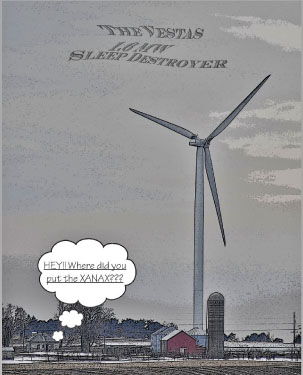 Here is the response: "Turbines are sited to have maximum sound level of 45dBA, well below levels causing physical harm. Medical books on sound indicate sound levels above 80-90dBA cause physical (health) effects. The possible effects to a person's health due to "annoyance" are impossible to study in a scientific way, as these are often mostly psychosomatic, and are not caused by wind turbines as much as the individuals' obsession with a new item in their environment."
Here is the response: "Turbines are sited to have maximum sound level of 45dBA, well below levels causing physical harm. Medical books on sound indicate sound levels above 80-90dBA cause physical (health) effects. The possible effects to a person's health due to "annoyance" are impossible to study in a scientific way, as these are often mostly psychosomatic, and are not caused by wind turbines as much as the individuals' obsession with a new item in their environment."
Community noise experts Kamperman and James took issue with this and published a formal response to the questionnaire, highlighting major deficiencies in the wind developers' statements, including:
* The tone and context of the statement implies that 45 dBA is fully compatible with the quiet rural community setting.
* No acknowledgement is made of the dramatic change this will be for the noise environment of nearby families.
* No mention is made of how the wind facility, once in operation, will raise evening and nighttime background sound levels from the existing background levels of 20 to 30 dBA to 45 dBA.
* There is no disclosure of the considerable low frequency content of the wind turbine sound; in fact, there are often claims to the contrary.
* They fail to warn that the home construction techniques used for modern wood frame homes result in walls and roofs that cannot block out a wind turbine's low frequencies.
* They do not disclose that the International Standards Organization (ISO) in ISO 1996-1971 recommends 25 dBA as the maximum night-time limit for rural communities. Sound levels of 40
dBA and above are only appropriate in suburban communities during the day and urban communities during day and night. There are no communities where 45 dBA is considered acceptable at night.
* Making statements outside their area of competence, wind industry advocates, without medical qualifications, label complaints of health effects as "psychosomatic" in a pejorative manner that implies the complaints can be discounted because they are not "really medical" conditions. Such a response cannot be considered to be based in fact.
NOTE FROM THE BPWI RESEARCH NERD: Developers and Wind Lobbyists alike compare the sound of industrial wind turbines to that of a refrigerator. The source of this statement seems to come from Tom Gray, a lobbyist for the American Wind Energy Association, and he can't seem to decide how far from the refrigerator you need to be in order to make the comparison, as illustrated by the video below.
UPDATE ON THE ICE THROW FROM AN INDUSTRIAL WIND TURBINE
(Click here to read it at its source)
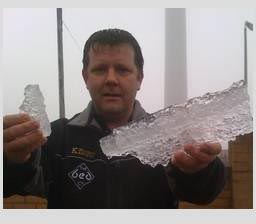 Residents complained when the 260ft wind generator began hurling shards of ice, some measuring two feet long, after the cold snap over the weekend.
Residents complained when the 260ft wind generator began hurling shards of ice, some measuring two feet long, after the cold snap over the weekend.
Operators Cornwall Light and Power turned off the machine in Kings Dyke, Whittlesey, Cambs, which is situated next to several homes and an industrial estate.
The energy company has also opened an investigation amid fears that the ice could have caused serious injury to people living and working near the turbine.
Tyson Clark, who owns a carpet showroom next to the generator, said he called Cornwall Light and Power demanding that it be turned off when lumps of ice started falling on his premises.
He told his local newspaper, the Wisbech Standard: "We have been told the turbine will stay off until the company has some satisfactory answers to why it happened."
The turbine was restarted a day later but had to be switched off again after more people complained.
Peter Randall, who runs a nearby welding company, said: "We were assured that ice could only cause a problem in severe weather conditions like those in Scotland, and two days later we got javelins thrown at us.
"I am worried about the safety of my family and everyone in the area, we should not have to put up with this."
The £2million turbine was criticised by many local residents when it was erected.
Whittlesey county councillor Ronald Speechley said: "It's worrying. Ice froze on the blades and, when it started moving, it started throwing it all over.
"It could be very dangerous."
A spokesman for Cornwall Light and Power said: "Following reports of ice shedding on Saturday, we shut down our wind turbine at Whittlesey.
"Our people have visited the site and nearby residents, and we have agreed that the turbine will not generate until we are fully satisfied that there is no risk of ice shedding."
1/24/08 How Were The Wind Rights to Magnolia Township Sold And What Does A WInd Developer Do?
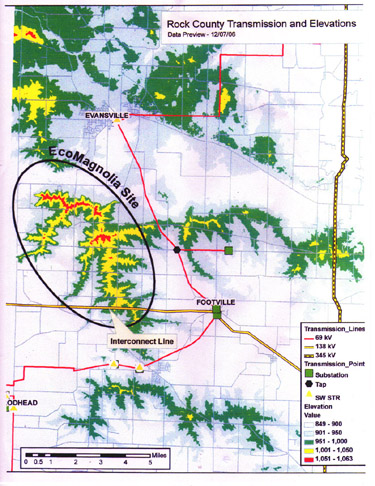 WHAT WAS SOLD AND HOW
WHAT WAS SOLD AND HOW
BPRC contacted EcoEnergy to ask what it was they sold when they sold wind development rights in our community to Acciona of Spain. We are grateful for this response, and appreciate their willingness to correspond with us, in spite of our differing views about this project. We were asked to print their response in its entirety and we are very glad to do so.
(Click here to visit EcoEnergy's Web Site)
From EcoEnergy:
“The question has come up regarding what EcoEnergy sold to Acciona and how EcoEnergy acquired this asset. In the case of the EcoEnergy arrangement with wind power leader Acciona, here's how it works. EcoEnergy does the initial project development, which includes locating good spots for turbines (based on wind maps and proprietary research related to wind patterns) and if local landowners are interested in participating, EcoEnergy then takes the project through the permitting process. At the end of the process, Acciona becomes the majority owner in the project and EcoEnergy retains an option for ownership and involvement in the ongoing operation to ensure a local, domestic presence. Both companies work together in the engineering and construction of the wind facility. In other words, EcoEnergy sold Acciona several wind project limited liability corporations. These corporations had assets, including proprietary wind data and analysis, geospatial analysis, project management, and staff time that was invested in meeting with local community members and groups. Thus, Acciona bought EcoEnergy’s development rights for the project LLC. This does not prevent another wind energy developer from working with the community, nor does it prevent community members from deciding to participate in a different project. It simply means that if EcoEnergy develops the project, Acciona will be majority owner.
It may make it clearer if we compare this arrangement with other types of long-term lease or ownership situations. In a new large building, for example, a private or public entity purchases the land for the building (roughly equivalent to the landowners in a wind facility project). In most cases, then, a developer is hired to find tenants for the proposed building (part of EcoEnergy's role, roughly equivalent to taking the project through the permitting process). A construction firm does the actual building (roughly equivalent to roles played by EcoEnergy and Acciona in this case, working together). At that point, the operation of the building is often turned over to a firm that manages it for its lifetime, including handling all its repairs and maintenance, and to whom the tenants of the building (assuming it's not a condo-type situation) pay their rent. The original owners still own the land on which the building sits, but they are not responsible for the day-to-day upkeep of the building. They receive a share of the profits from the project, but the firm managing the building for its lifetime may often be referred to as the owner and for all intents and purposes related to the running of the building, it is. It makes its money by managing the building and making sure it is well-maintained. In the case of a wind facility owned and operated by EcoEnergy and Acciona, these two companies are roughly equivalent to the firm that operates the building -- they "own" the equipment and the operation of the turbines, but the land is still owned by the original landowners, who receive annual payments for the use of that land, just as the owners of the large building -- while not involved in its day-to-day activities -- still receive payments based on its success.”
THANK YOU ECOENERGY FOR THAT RESPONSE! Please know it is appreciated.
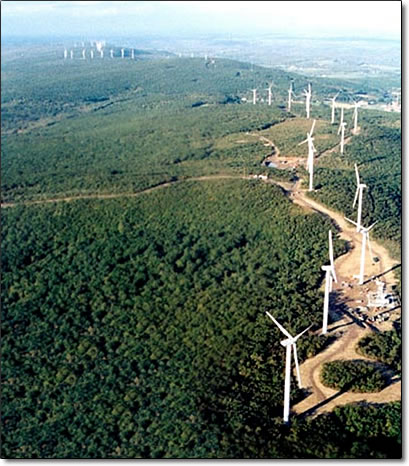
WHAT'S A WIND
PROJECT DEVELOPER?
Need a job?
The BPRC Research Nerd has learned that Acciona of Spain has a branch in Chicago and they're looking for someone who can develop wind energy projects like the one developed and sold in our area by EcoEnergy.
(Read the ad at its original source by clicking here)
Acciona Energy North America Corporation
Title: Project Developer
Location: Chicago, IL
Sector: Alternative Energy
Occupation: Business Development
Education: Bachelors/Physical Science or Engineering
Benefits 401K
Other Features :Travel75%
Description: Acciona is a global pioneer in contributing to sustainable worldwide development through its main lines of business: development and management of infrastructure and real estate projects, provision of transport, urban and environmental services, and development and operation of renewable energies.
Acciona seeks seasoned professionals to assist in the development of utility-scale wind power projects. We have openings in San Diego, Chicago,and Toronto. This position reports to the regional head of development. This senior project management position will be responsible for all aspects of project delivery for multiple projects in specific regions throughout the United States, ensuring that their projects are completed on time and on budget. The Project Developer’s initial charter will be to focus on managing existing projects. As the U.S. and Canadian business grows, he/she will be responsible for identifying and securing new development sites, evaluating project acquisition and investment opportunities and mentoring junior staff members.
Duties/Responsibilities:
# Manage process to move projects from green field development to commercial, preconstruction stage
# Ensure that timelines and budgets for Company’s existing projects are effectively managed
# Coordinate feasibility studies and project development activities with cross functional resources, peers, and outside consultants to ensure project stays on track
# Negotiate land rights acquisition with landowners and address land use issues
# Work with Permitting Manager to define, apply for and manage complex federal, state, and local environmental, construction, and related permits and support community outreach efforts towards a variety of stakeholders
# Work with Staff Scientist to coordinate wind resource assessment activities
# Work with Power Market and Interconnection Manager to manage interconnection studies, load flow analyses and assist in PPA negotiations
# Identify and communicate to Vice President any project risks and develop mitigation strategies
# Identify and introduce new potential joint venture partners, project acquisition opportunities and green field sites
# Identify and develop relationships with stakeholders; effectively communicate with a range of personalities, including land owners, partners, government officials, technical experts, utilities, and consultants
# Manage project budget, schedule and financial modeling inputs; communicate any variance to V.P.
# Prepare and present detailed analysis; communicate status reports to V.P.
Skills Required:
# Bachelor’s degree in Physical Science or Engineering
# Previous experience in energy development required, preferably in wind energy project development, with an understanding of deregulated electric markets
# At least 5+ years in a project management position with proven track record of building, leading and managing a multi-disciplinary team, preferably in the renewable energy or power generation industry
# Excellent written and oral communications skills; the ability to develop clear and concise development plans and presentations covering project status, timeline, risk assessment, and budget needs and performance
# Ability to operate at a detailed level, to organize and multi-task, with a dedication to seeing projects through to completion
# Ability to read and interpret topographic and other land use maps, preferably with some experience with Graphic Information Systems
# Understanding of local community dynamics, with the ability to negotiate effectively with landowners, permitting authorities, utilities, and other stakeholders
# Understanding of cost accounting, budgeting, and contract implementation
# Works well in a team environment and must be able to collaborate
# Business and utility industry experience preferred
# Willingness to travel regionally (generally 20%, but at times up to 50%)
